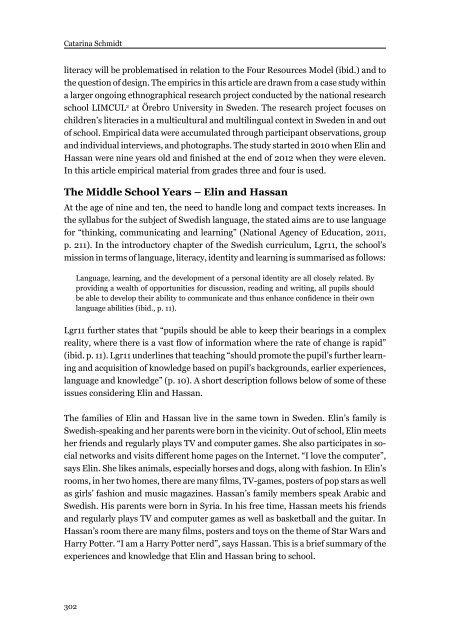Download issue - Umeå universitet
Download issue - Umeå universitet
Download issue - Umeå universitet
You also want an ePaper? Increase the reach of your titles
YUMPU automatically turns print PDFs into web optimized ePapers that Google loves.
Catarina Schmidt<br />
literacy will be problematised in relation to the Four Resources Model (ibid.) and to<br />
the question of design. The empirics in this article are drawn from a case study within<br />
a larger ongoing ethnographical research project conducted by the national research<br />
school LIMCUL 2 at Örebro University in Sweden. The research project focuses on<br />
children’s literacies in a multicultural and multilingual context in Sweden in and out<br />
of school. Empirical data were accumulated through participant observations, group<br />
and individual interviews, and photographs. The study started in 2010 when Elin and<br />
Hassan were nine years old and finished at the end of 2012 when they were eleven.<br />
In this article empirical material from grades three and four is used.<br />
The Middle School Years – Elin and Hassan<br />
At the age of nine and ten, the need to handle long and compact texts increases. In<br />
the syllabus for the subject of Swedish language, the stated aims are to use language<br />
for “thinking, communicating and learning” (National Agency of Education, 2011,<br />
p. 211). In the introductory chapter of the Swedish curriculum, Lgr11, the school’s<br />
mission in terms of language, literacy, identity and learning is summarised as follows:<br />
Language, learning, and the development of a personal identity are all closely related. By<br />
providing a wealth of opportunities for discussion, reading and writing, all pupils should<br />
be able to develop their ability to communicate and thus enhance confidence in their own<br />
language abilities (ibid., p. 11).<br />
Lgr11 further states that “pupils should be able to keep their bearings in a complex<br />
reality, where there is a vast flow of information where the rate of change is rapid”<br />
(ibid. p. 11). Lgr11 underlines that teaching “should promote the pupil’s further learning<br />
and acquisition of knowledge based on pupil’s backgrounds, earlier experiences,<br />
language and knowledge” (p. 10). A short description follows below of some of these<br />
<strong>issue</strong>s considering Elin and Hassan.<br />
The families of Elin and Hassan live in the same town in Sweden. Elin’s family is<br />
Swedish-speaking and her parents were born in the vicinity. Out of school, Elin meets<br />
her friends and regularly plays TV and computer games. She also participates in social<br />
networks and visits different home pages on the Internet. “I love the computer”,<br />
says Elin. She likes animals, especially horses and dogs, along with fashion. In Elin’s<br />
rooms, in her two homes, there are many films, TV-games, posters of pop stars as well<br />
as girls’ fashion and music magazines. Hassan’s family members speak Arabic and<br />
Swedish. His parents were born in Syria. In his free time, Hassan meets his friends<br />
and regularly plays TV and computer games as well as basketball and the guitar. In<br />
Hassan’s room there are many films, posters and toys on the theme of Star Wars and<br />
Harry Potter. “I am a Harry Potter nerd”, says Hassan. This is a brief summary of the<br />
experiences and knowledge that Elin and Hassan bring to school.<br />
302

















